I watched it happen in real-time. A sales rep picked up the phone, ready to close, but the caller sounded impatient. “I already spoke to someone,” they said. My colleague at one of my earlier jobs scrambled: there was no conversation record, and they had no idea which campaign brought them in. That call, which could have closed a high-value deal, became another missed opportunity.
That moment made me realize the importance of using the best inbound call tracking software. We were tracking website visits, email opens, and ad clicks. Yet, every time the phone rang, we had zero visibility into where those leads were coming from or how to follow up effectively.
Recently, I evaluated the best inbound call tracking software solutions to help you avoid similar situations. Whether you're a solo marketer or looking for highly recommended inbound call trackers for enterprises, there’s a tool here for you
I reviewed hundreds of G2 reviews about call attribution, analytics, automation, and integrations, which are essential for every business to turn every call into an opportunity. These insights helped me identify the top-rated call tracking services trusted by real users for performance, reliability, and marketing ROI.
8 best inbound call tracking software: My picks
-
CallRail: Best for comprehensive lead intelligence
Offers detailed call tracking across marketing channels (plans start at $45/mo)
-
Invoca: Best for AI-powered conversation intelligence
Uses AI to analyze calls and enhance marketing campaigns (pricing on request)
-
Ozonetel CloudAgent: Best for cloud-based contact centers
Delivers seamless customer service through a fully cloud-based platform (pricing on request)
-
WhatConverts: Best for tracking all marketing leads
Goes beyond phone calls to track e-commerce transactions (pricing on request)
-
CallTrackingMetrics: Best for integrated call tracking and business phone systems
Combines marketing call tracking with a robust phone system (plans start at $65/mo)
-
Vonage Contact Center (formerly NewVoiceMedia): Best for Salesforce integration
Enables easy Salesforce integration to streamline sales, marketing, and support workflows. (pricing on request)
-
Ringover: Best for advanced call center features with CRM integration
A cloud-based phone solution with call center functionality (starting at $21/mo)
-
800.com: Best for toll-free number solutions
Provides toll-free numbers with extras like call recording, voicemail, and texting. (plans start at $19/mo)
*These inbound call tracking software solutions are top-rated in their category, according to G2's Spring 2025 Grid Reports. I’ve also added their pricing to make comparisons easier. Each ranks among the leading inbound call tracking tools for usability, feature set, and customer satisfaction, especially when evaluated by real users across different industries.
My experience researching the best inbound call tracking software
I view inbound call tracking software as a tool that enables businesses to monitor, analyze, and optimize their phone call interactions. It assigns unique phone numbers to marketing channels, such as ads, landing pages, or social media, so users can see which campaigns drive the most calls. When a customer dials one of these numbers, the software captures details such as the caller’s number, location, call duration, and even the conversation transcripts. This allows users to understand customer behavior, attribute calls to the right sources, and refine marketing strategies for better ROI — especially since about 37% of phone leads convert during the call across industries, underscoring how valuable accurate attribution is.
How did we find and evaluate the best inbound call tracking software?
I explored inbound call tracking software at all levels, from basic tools that log caller details and call volume to advanced platforms with artificial intelligence-powered analytics, call attribution, dynamic number insertion, and customer relationship management system (CRM) integrations. I evaluated their core functionalities and analyzed feedback from businesses to assess real-world effectiveness.
I examined hundreds of G2 reviews, cross-referencing my findings with G2’s Grid Reports to ensure accuracy, usability, efficiency, and overall value. After extensive research, I’ve compiled a list of the best inbound call tracking software for businesses of all sizes.
I also consulted professionals with firsthand experience and verified their insights against trusted G2 reviews. The screenshots in this article include a mix of those sourced from vendor G2 pages and publicly available material.
The best inbound call tracking software should do more than just log calls. It must offer dynamic number insertion (DNI) to track calls based on visitor sessions and provide real-time analytics to identify high-quality leads. Seamless integration with CRMs, Google Analytics, and ad platforms is essential for accurate marketing attribution. I also look for AI-powered call recording and transcription to help sales teams understand conversation trends.
How I evaluated the best inbound call tracking software
Here’s what I considered while exploring the best inbound call tracking software solutions.
- Dynamic number insertion: Users need inbound call tracking software that supports dynamic number insertion to track calls based on user sessions. This ensures they can see which specific marketing source, Google Ads, social media, or organic search, led to a call. Without DNI, you're stuck with static tracking numbers, which don’t provide the granular insights needed to optimize campaigns effectively.
- Call attribution and source tracking: Accurate call attribution is non-negotiable. A good software should tell exactly which campaign, ad, keyword, or webpage drove each inbound call. Ideally, it should support multi-touch attribution, so users can see the full customer journey instead of just the last touchpoint before a call. The better the attribution, the more effectively teams can allocate their marketing budget. This is especially crucial for fast-scaling teams evaluating top inbound call tracking platforms for tech startups.
- CRM and marketing platform integration: Inbound call tracking is only useful if it operates in conjunction with other platforms. I focus on tools that integrate seamlessly with CRM, Google Analytics, Google Ads, Facebook Ads, and other marketing automation tools. This ensures that sales and marketing teams have real-time access to call data, making it easier to follow up on leads and accurately measure ROI.
- AI-powered call recording and transcription: A good inbound call tracking tool should analyze conversations. AI-driven call recording and transcription allow users to review customer interactions, extract key insights, and even identify patterns in sales calls. If the software includes keyword spotting and sentiment analysis, that’s a significant advantage for enhancing sales strategy.
- Call routing and IVR capabilities: If your business handles a high volume of inbound calls, you need smart call routing and an interactive voice response (IVR) system. These ensure that calls are directed to the correct department or sales representative based on predefined rules, thereby improving response times and the overall customer experience. Some advanced platforms even use AI to route calls based on intent analysis.
- Ease of use and customer support: Even the most feature-rich software is useless if it’s too complicated to use. I look for an intuitive dashboard, simple setup, and easy-to-understand reporting tools. It's also important to have responsive customer support with live chat, phone, and email options, ideally 24/7, especially if the business operates across multiple time zones.
To be included in the inbound call tracking software category, a product must:
- Create unique tracking phone numbers for various marketing campaigns
- Link incoming calls and messages to specific ads, campaigns, or keywords
- Capture and track all inbound calls associated with each tracking number.
- Deliver real-time analytics and detailed call reports
- Sync with marketing and sales platforms to analyze lead data and conversion metrics
*This data was pulled from G2 in 2025. Some reviews may have been edited for clarity.
1. CallRail: Best for comprehensive lead intelligence
Users appreciate how CallRail helps identify which marketing efforts drive the most calls. Instead of blindly guessing which campaigns are working, they can see concrete data on which ads, keywords, or sources generate phone leads. This feature gives users confidence in marketing spend and helps refine future strategies. They don't have to rely on assumptions or incomplete customer feedback.
One thing I’ve seen G2 reviewers highlight is the helpfulness of CallRail’s AI-powered conversation summaries. Instead of listening to full recordings or scanning entire transcripts, users can quickly get a summary of each call. It’s a huge time-saver especially for teams managing a high volume of calls each day.
Call routing also gets strong feedback. Reviewers mention that CallRail automatically directs calls to the right person or team, helping potential customers avoid unnecessary transfers or wait times. This improves the caller experience and reduces the risk of missed leads due to unanswered or misdirected calls.
Access to call recordings is another notable feature. According to G2 Data, 93% reviewers said its call recording feature is valuable for training and quality monitoring. If you’re managing a sales or support team, being able to reference actual conversations makes coaching far more effective than relying on general feedback alone
For smaller teams that need robust insights without the complexity of enterprise-level solutions, CallRail is often considered the best inbound call tracking software for small businesses, thanks to its user-friendly dashboard and affordable pricing tiers.
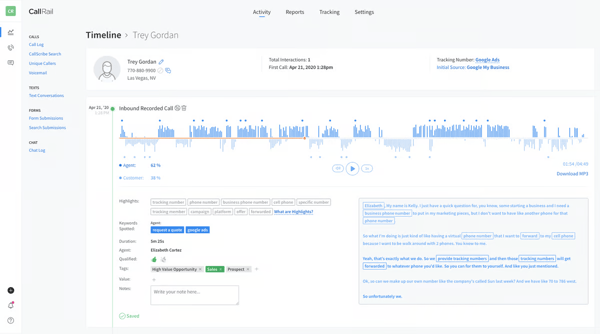
One of the biggest challenges in marketing is proving ROI, and I’ve seen G2 reviewers mention that CallRail makes this easier. Users appreciate being able to track which campaigns, keywords, or ads drive phone calls, especially for businesses where conversions happen over the phone rather than through online forms.
Instead of guessing whether ad spend is paying off, users can clearly see which sources are generating leads. While a few users find the initial setup a bit time-consuming, especially if they aren’t very tech-savvy, most agree that once it’s configured, the insights gained are well worth the effort.
Another strength users highlight is how clearly the platform presents call data for evaluating campaigns. Although a few reviewers mentioned occasional issues with calls not being logged or recorded properly, many still trust the overall reporting because the system provides a comprehensive view of lead sources and performance.
When it comes to notifications, users like getting alerts for important calls. Some wish the system allowed more customization and urgency, yet most still value the real-time alerts as a useful way to stay on top of key interactions.
Lastly, reviewers see potential for more automation after a call ends. While CallRail currently lacks extensive built-in follow-up tools, like automatically sending a text or email, users still find its lead management features strong enough to support timely follow-ups through other integrated tools.
What I like about CallRail:
- I’ve seen G2 users highlight how CallRail eliminates the guesswork in marketing. Being able to see exactly which campaigns lead to phone calls helps teams invest in the right strategies without relying on assumptions.
- AI-powered call summaries are another favorite. I've observed G2 reviewers note that, instead of listening to full recordings, they can quickly grasp the gist of a conversation, making it easier to manage multiple calls efficiently.
What G2 users like about CallRail:
“I like that it tracks where our marketing dollars are spent, the return rate for where we should invest more, and what to invest less in. It is very valuable for this. Used for years. It was very easy to set up in my portal, which we use for the added numbers. We can call customer support for clarification if needed.”- CallRail Review, Mary W.
What I dislike about CallRail:
- Configuring tracking numbers and routing takes time, and I’ve seen G2 reviewers mention that someone who’s not very tech-savvy might struggle with the process. The insights are valuable, but getting everything set up correctly requires some patience.
- I’ve also seen reviewers point out that missing call data can be a concern. Even a small percentage of untracked calls can impact the accuracy of marketing reports, making it more challenging to trust the full picture when making decisions based on that data.
What G2 users dislike about CallRail:
“Setting up can be time-consuming to be able to track everything you do for marketing.”
- CallRail Review, Michael K.
2. Invoca: Best for AI-powered conversation intelligence
Users appreciate how Invoca delivers real-time data, enabling businesses to act immediately on customer insights. This is critical for industries where quick decision-making can improve conversion rates or customer satisfaction. Having immediate access to call data means that marketing and sales teams can adjust strategies without delays.
Training is often a hurdle with new software, but I’ve seen G2 reviewers consistently highlight Invoca’s onboarding process as a strength. Many users say they were able to navigate the platform effectively after a short training session, which suggests Invoca puts real effort into user education. A well-structured training experience minimizes downtime and helps teams ramp up quickly.
Another standout is the depth of caller insights. According to G2 Data, 90% reviewers said it provides representatives with caller data upon receiving a phone call, helping them better understand and respond to the caller.
I noticed reviewers praising how Invoca goes beyond basic metrics, such as call duration or phone number; it captures customer intent and behavior. This level of detail enables more personalized follow-ups and stronger customer interactions. The more granular the data, the more useful it becomes for refining both marketing and sales strategies
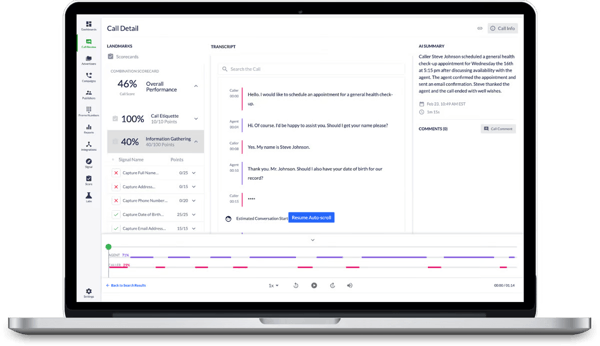
Some tools start great but become unreliable over time, yet Invoca appears to be a consistent performer. I like that users who have used it for an extended period report continued satisfaction, which speaks to the platform’s reliability.
While some reviews highlight a challenge with the lack of built-in support for certain data parameters, which makes it harder to track specific interactions and forces workarounds, many still find that dependable performance and stable tracking offset these occasional limitations.
What I like about Invoca:
- I’ve seen G2 users appreciate how Invoca delivers real-time data, enabling teams to act on customer insights without delay. Quick access to call analytics enables marketing and sales teams to adjust their strategies in real-time as conversations occur.
- Another thing I've observed G2 reviewers highlight is the depth of insight from the caller. Invoca goes well beyond basic call logs by capturing details about customer intent, making it easier to personalize follow-ups and improve overall engagement.
What G2 users like about Invoca:
“Invoca's Conversation Analytics, powered by AI, allows deep views into customer interactions using machine learning technology. Invoca enables call tracking, attributes call conversions to the campaigns that drive them, and results in the optimal use of ad dollars. We recently implemented Invoca's affiliate pay-per-call module. This allowed us to track our cost per call and cost per appointment metrics in real-time from the pay-per-call program, which is a huge win for the team as we had to wait 6 weeks earlier to get the cost data.”- Invoca Review, Jigna D.
What I dislike about Invoca:
- I’ve seen G2 reviewers mention a few areas with room for improvement, such as better match rate accuracy with CRM data, more intuitive reporting and filtering, easier Salesforce integration, and a smoother process for expanding licenses.
- I’ve also noticed that the lack of built-in support for certain data parameters can be a challenge. Some users mention having to rely on workarounds to track specific interactions, which adds extra complexity to the process.
What G2 users dislike about Invoca:
“The reporting tools can be a bit clunky. We have not found a way to create collaborative custom reports in-platform, as each can only be viewed by the individual owner and shared (but not edited). Additionally, you will need to wait for an email link to download reports/data, rather than accessing them directly from your computer's files. Deeper integration with Microsoft Search Ads would be nice as well.”
- Invoca Review, Verified User in Marketing and Advertising
Looking for tools to automate outbound calls? Explore the top auto dialers to try.
3. Ozonetel CloudAgent: Best for cloud-based contact centers
G2 reviewers appreciate Ozonetel CloudAgent’s depth of call reports. Having access to detailed call analytics helps understand customer behavior and agent performance. The ability to track specific call trends, such as peak call times or frequently asked queries, allows businesses to optimize their customer service strategy.
I’ve seen G2 reviewers highlight how Ozonetel CloudAgent excels at efficiently distributing incoming calls. The system helps reduce wait times by routing calls to the appropriate agents based on predefined criteria, such as department or skill set. For businesses handling high call volumes, this kind of smart routing minimizes congestion and improves the overall caller experience.
Another feature that gets strong feedback is call monitoring. Users appreciate that supervisors can listen to live calls and provide real-time coaching. It’s a valuable tool for training and quality assurance, allowing intervention while the conversation is still happening, rather than waiting for post-call reviews.
Reliability also stands out in reviews. I’ve noticed users mention that the platform experiences minimal downtime, which is crucial for businesses that rely heavily on inbound calls. Knowing the system remains stable and consistently available gives teams confidence that they won’t lose revenue or miss critical customer interactions.
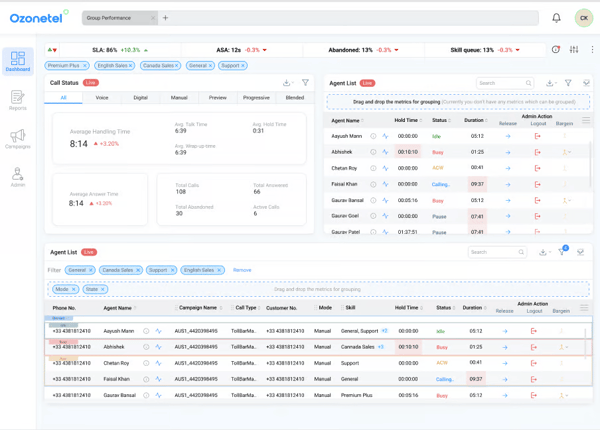
Users often praise the platform for its efficient call tracking, which helps teams stay on top of customer interactions. One issue I’ve seen mentioned in G2 reviews is call overlapping during peak times. When there’s a surge in inbound calls, multiple agents may try to pick up the same call, which creates confusion and slows down response times. Even so, many reviewers note that the system’s strong tracking and routing features generally help manage high call volumes effectively.
While the reporting feature is generally strong, I’ve noticed feedback about occasional inconsistencies in certain reports. When data isn’t accurate or complete, it can lead to misinformed decisions, especially for teams that rely on analytics to monitor performance and identify trends. Still, users appreciate that the platform offers in-depth reporting capabilities that make it easier to track key metrics once any minor discrepancies are addressed.
What I like about Ozonetel CloudAgent:
- Ozonetel CloudAgent provides detailed call reports that help track customer behavior and agent performance. I've noticed G2 users mention that identifying call trends enables them to make informed decisions and optimize their service.
- I've noticed that the system distributes calls based on agent skills or departments, reducing misrouted calls and long wait times. This structured approach makes the process smoother and improves customer satisfaction.
What G2 users like about Ozonetel CloudAgent:
“From my experience, I have been using Ozonetel for over two years with very few complaints. We have hardly faced any issues. One thing worth highlighting is Ozonetel’s service; any complicated issue can be resolved within minutes.Accessing Ozonetel is smooth, with no bugs or issues while using it. Calls connect easily; we haven’t received any complaints about call connectivity. I would recommend Ozonetel CloudAgent to companies.”- Ozonetel CloudAgent Review, Bhavana N.
What I dislike about Ozonetel CloudAgent:
- I’ve noticed that during peak hours, multiple agents sometimes try to pick up the same call, which can lead to confusion and delays.
- I’ve seen G2 reviewers mention that accurate reporting is critical for decision-making, so it’s concerning when data inconsistencies show up.
What G2 users dislike about Ozonetel CloudAgent:
“There are issues with the software. When an agent is on call, the dashboard still shows idle status. There is a restriction on downloading the data; at a time, only two months' data can be downloaded.”
- Ozonetel CloudAgent Review, Ritu L.
4. WhatConverts: Best for tracking all marketing leads
Users like how well WhatConverts attributes leads. It tracks calls and provides detailed insights into where those leads originated. This clarity makes it much easier to understand which marketing channels perform best. Optimizing campaigns can feel like a guessing game without this kind of insight. Knowing which ads, keywords, or sources drive quality leads is a huge advantage.
I’ve seen G2 reviewers consistently highlight how WhatConverts stands out with its clear and straightforward reporting. Unlike other tracking tools that can feel overly complex, users say this platform makes it easy to interpret data and take action quickly. As a marketer, I really value being able to identify high-quality leads without spending extra time deciphering reports.
Lead tracking accuracy is another strength. I’ve come across reviews mentioning that WhatConverts reliably captures calls and attributes leads correctly. For businesses that rely on phone inquiries, having consistent and trustworthy data is crucial, and this tool appears to deliver it well. In fact, 87% businesses choose WhatConverts for their inbound call tracking needs.
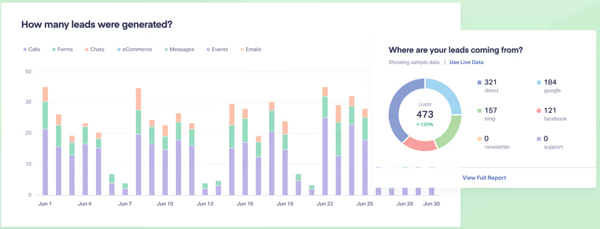
Many G2 users highlight WhatConverts as a cost-effective solution for tracking leads and understanding marketing performance. While some mention that the pricing structure can be a bit unclear, making it hard to predict how costs scale with usage, most still feel that the overall value justifies the investment.
Another strength is its ability to track leads across campaigns, helping teams clearly see which marketing efforts drive results. Though it doesn’t offer full client management features like a traditional CRM, this isn’t a major issue for teams already using a dedicated CRM. For those seeking an all-in-one solution, the lack of built-in CRM capabilities may feel limiting; however, its lead tracking focus remains a clear advantage.
Users also appreciate the platform’s straightforward reporting, although some feedback suggests that it’s primarily geared toward U.S.-based businesses. For international users, aspects such as phone number formatting, support hours, or region-specific features may create some friction; yet, many still find the platform effective and reliable for managing leads worldwide.
What I like about WhatConverts:
- I’ve seen G2 users appreciate how WhatConverts tracks calls and clearly shows where leads are coming from.
- WhatConverts is considered one of the most effective inbound call tracking apps for agencies managing multi-client campaigns. I've noticed reviewers mention that the clarity helps them act faster and make better decisions.
What G2 users like about WhatConverts:
“We spent a lot of time and effort researching numerous tools for conversion tracking. Most of the other tools we tested did one or two things well, but could not track all the types of conversions we needed. We love that WhatConverts tracks phone calls, form submissions, chats, purchases, appointments, and more. For growing companies without enterprise budgets, it’s also one of the best inbound call tracking software for small businesses aiming to unify multi-channel lead tracking. Additionally, it's particularly helpful that their system has numerous third-party integrations, accompanied by extensive setup documentation. Additionally, support is exceptionally responsive to our requests or questions.”- WhatConverts Review, Ben S.
What I dislike about WhatConverts:
- I’ve noticed that while WhatConverts is often described as cost-effective, some users mention that the pricing structure can be tricky to navigate. It’s not always clear how costs scale with usage, which can make budgeting and forecasting more difficult.
- I’ve seen G2 reviewers point out that although WhatConverts has strong lead tracking capabilities, it doesn’t function as a full CRM. For businesses requiring more advanced client management features, integrating an additional tool is often necessary, which can be a drawback for those seeking an all-in-one solution.
What G2 users dislike about WhatConverts:
“At this stage, we don't have much to discuss regarding dislikes. Initially, we found their pricing confusing, but it makes much more sense once we dive in.”
- WhatConverts Review, Donovan R.
5. CallTrackingMetrics: Best for integrated call tracking and business phone systems
Users like CallTrackingMetrics’ ability to attribute calls effectively. It can pinpoint whether a call came from paid ads, organic search, or other sources, providing detailed insights into campaign performance. This level of attribution helps marketers like me fine-tune their marketing strategies without relying on guesswork.
G2 reviewers often highlight how CallTrackingMetrics goes beyond basic call counts by offering detailed call analytics. The platform gives users a clear view of customer interactions, including caller behavior, call duration, and trend patterns. This level of granularity is especially helpful for adjusting customer experience strategies in real time based on actual call data.
Location-based insights are another standout. I’ve seen feedback from users who found it valuable to understand where calls are coming from, particularly for businesses operating across multiple regions. These insights help teams identify which areas generate the most engagement, making it easier to optimize local marketing efforts or guide expansion strategies.
Another benefit reviewers mention is that even businesses using a single phone line can still take advantage of CallTrackingMetrics’ tracking capabilities. Users like that they don’t need to manage multiple tracking numbers to get meaningful insights, simplifying the process without sacrificing visibility into performance. This kind of flexibility is why many consider it among the best mobile-friendly call tracking software options, offering full access to reports, call logs, and campaign data, whether you’re in the office or working remotely
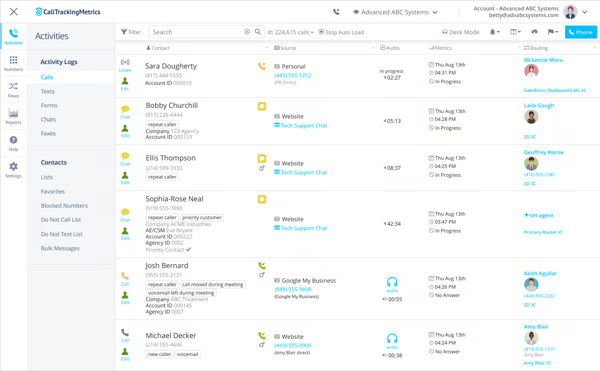
G2 reviewers often praise CallTrackingMetrics for its feature-rich platform that supports robust call tracking and analytics. While the onboarding and setup process can sometimes take longer than expected, some users have reported delays that stretch months beyond initial timelines. Many still find the platform’s wide range of features worth the initial investment of time.
Another strength is its powerful call tracking capabilities, which give teams valuable insights into marketing performance. Spam filtering, however, is an area where users see room for improvement. The platform doesn’t always block unwanted calls effectively, which can skew reporting and require manual cleanup. Even so, users value the detailed analytics and reporting that help them stay on top of key metrics, despite occasional issues related to spam.
Users also appreciate the platform’s advanced analytics, though several noted that deeper customization can be difficult without API access. For teams with specific workflow requirements, this can lead to workarounds or extra development effort. Still, the built-in tracking and reporting tools are strong enough to meet the needs of most businesses without heavy customization.
What I like about CallTrackingMetrics:
- I’ve seen G2 users highlight how CallTrackingMetrics does a great job of attributing calls to specific sources, such as paid ads, organic search, and other campaigns.
- Location tracking is another feature that gets strong praise. I've noticed reviewers say it’s especially useful for businesses targeting specific regions, since it shows which geographic areas are generating the most engagement.
What G2 users like about CallTrackingMetrics:
“The detailed call analytics provide clear insights into which campaigns drive calls and customer engagement. We can easily track the ROI of our marketing efforts. The call recording feature has been useful for training and quality control. It allows us to review calls to ensure customer service standards are met. It integrates seamlessly with our CRM, making it a convenient option for our users, particularly given its frequent use. We could set up different phone numbers for different campaigns using customizable tracking numbers. This made it easier to identify which strategies were effective. Customer support has been excellent, as we receive clear answers to our questions and prompt assistance in resolving issues.”- CallTrackingMetrics Review, Loganathan V.
What I dislike about CallTrackingMetrics:
- I’ve noticed that setting up CallTrackingMetrics can take longer than expected, which might be frustrating for businesses eager to start tracking and optimizing their marketing efforts.
- I’ve seen G2 reviewers mention that spam calls can still appear in reports, cluttering the data and affecting accuracy. For businesses that receive a high volume of spam, this can become a recurring hassle.
What G2 users dislike about CallTrackingMetrics:
“The learning curve can be challenging for users unfamiliar with call tracking analytics. Small businesses with limited budgets may also find the pricing too expensive.”
- CallTrackingMetrics Review, Supriya R.
6. Vonage Contact Center (formerly NewVoiceMedia): Best for Salesforce integration
G2 reviewers like Vonage Contact Center’s competitive international calling rates. While inbound call tracking is often tied to domestic operations, having a reliable and cost-effective way to handle international calls is a game-changer. It ensures users don’t have to worry about excessive charges when dealing with customers from other countries.
G2 reviewers often highlight how Vonage Contact Center uses AI-driven analytics to improve inbound call handling. Users appreciate features such as AI-assisted call routing, sentiment analysis, and automated responses. These capabilities help reduce the workload on human agents while providing deeper insights into customer interactions. If you're wondering which call tracking software is best for marketing firms, Vonage Contact Center is a compelling option due to its in-depth analytics and seamless Salesforce integration.
Scalability is another area where Vonage gets strong feedback. I’ve seen reviews noting that the platform can handle high call volumes without lag or dropped calls, which is essential for businesses that rely heavily on inbound communication. That kind of reliability helps ensure customer satisfaction and prevents missed opportunities.
Call flow customization is also a key strength. According to users, the ability to tailor routing paths and direct callers to the right agents or departments makes the platform especially valuable for teams managing complex service requests or multi-step support workflows.
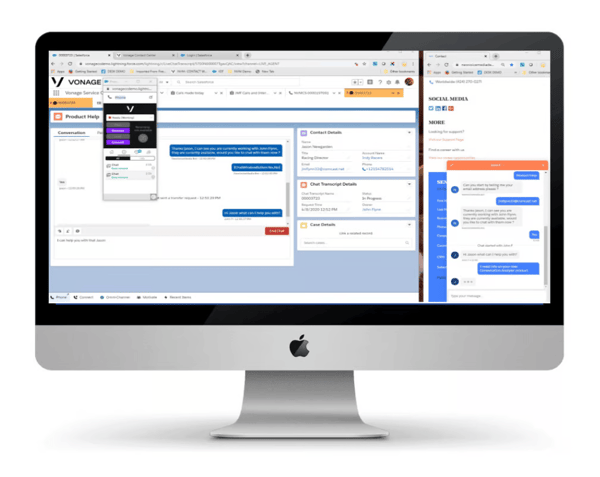
Users often highlight Vonage Contact Center’s AI-driven features, which help businesses efficiently handle large volumes of inbound calls. Some users have mentioned experiencing issues with messaging functions, which can be a drawback for businesses that rely on omnichannel communication.
If inbound call tracking software is expected to integrate seamlessly with SMS or other messaging platforms, reliability in this area is necessary. Even so, many reviewers still value the platform’s ability to manage calls effectively and keep customer interactions organized.
I’ve seen G2 users point out that while Vonage Contact Center offers powerful advanced tools, there can be a learning curve, especially when diving into these features. These capabilities may not feel intuitive right away and often require training or extra resources to use effectively. Yet, once users get accustomed to the system, they find the AI-driven insights and automation highly beneficial.
Another strength is its ability to provide real-time call management, ensuring smooth operations during busy periods. Customer support is another area where reviewers see room for improvement, as some users mention delays in getting help when issues arise. Still, many find the overall reliability and performance of the platform strong enough to outweigh occasional support delays.
What I like about Vonage Contact Center:
- I’ve seen G2 reviewers highlight how well Vonage Contact Center handles high call volumes without lag or dropped connections. This reliability ensures a smoother experience for both businesses and customers.
- I've noticed in G2 reviews that customizable call flows are another feature that gets strong praise. Users mention that being able to tailor how inbound calls are routed makes it easier to direct customers to the right agent or department.
What G2 users like about Vonage Contact Center:
“Vonage Contact Center offers a robust integration with Salesforce, making managing and tracking customer interactions easier within a unified platform. The tool's real-time call monitoring and reporting features are beneficial, enabling our team to consistently maintain high service standards. Additionally, the ease of use and straightforward implementation process allowed our team to quickly get up to speed without requiring extensive training. The customer support is responsive and has helped resolve issues promptly, which is crucial in maintaining our operations.”- Vonage Contact Center (formerly NewVoiceMedia) Review, Anshika S.
What I dislike about Vonage Contact Center:
- I’ve noticed that a few users have reported issues with Vonage’s messaging functions, which can make communication across channels less reliable.
- I’ve seen G2 reviewers mention that while Vonage Contact Center’s AI-driven tools are powerful, some businesses might find the learning curve for advanced features a bit challenging, as they need time and training to use them effectively.
What G2 users dislike about Vonage Contact Center:
“The wait time for a customer is a bit too long, especially when the customer care is meant to be there for the customer immediately when required.”
- Vonage Contact Center (formerly NewVoiceMedia) Review, Arshdev S.
7. Ringover: Best for advanced call center features with CRM integration
Ringover’s call quality is frequently praised by users. A strong and stable connection makes a significant difference when handling customer inquiries. Clear conversations reduce misunderstandings, ensuring you can provide accurate information without asking customers to repeat themselves. Many providers struggle with maintaining consistent audio clarity, but knowing that Ringover prioritizes this aspect gives users confidence in its reliability.
I’ve seen G2 users appreciate that Ringover offers call transcriptions, making it easier to track conversations without the need for manual note-taking. Even if the transcription isn’t flawless, reviewers say it provides a solid reference point for reviewing past calls and analyzing customer interactions.
Quick implementation is another standout feature. Many reviewers note that Ringover can be set up and running faster than other call tracking platforms. For businesses seeking to avoid lengthy onboarding processes or technical delays, this speed is a significant advantage. It’s a relief when a tool delivers on the promise of easy setup without requiring extensive support.
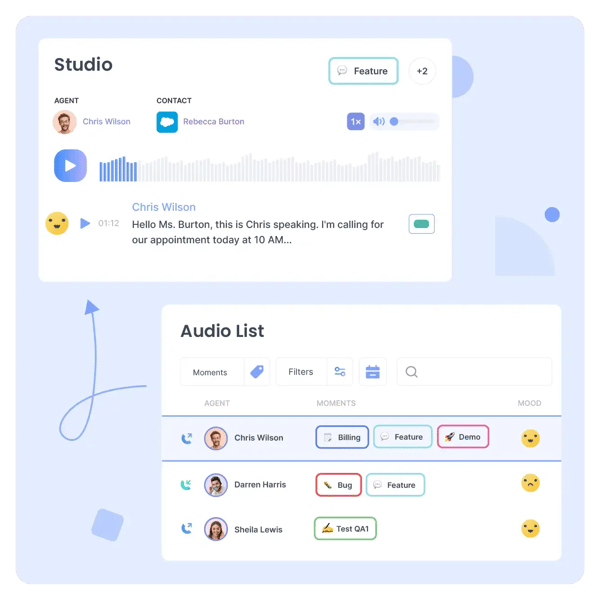
Users often appreciate Ringover’s advanced call tracking features, which help businesses manage customer interactions efficiently. One issue I’ve seen in G2 reviews is the accuracy of call transcriptions. While having a written record is helpful in theory, it can become a hassle if the transcript includes frequent errors.
Misinterpretations can easily lead to confusion, and for industries that rely on precise documentation, this lack of accuracy means extra time spent manually double-checking details. Still, many find the transcription feature valuable for quickly referencing call details even if occasional edits are needed.
Ringover is also known for its reliable call management, although some users mention that occasional dropped calls or audio delays can disrupt conversations and negatively impact the customer experience. Despite these rare disruptions, most reviewers report that overall call quality remains consistently strong.
Another strength is the platform’s rich routing capabilities, which give teams flexibility in managing inbound calls. Configuring routing rules or adjusting tracking parameters can sometimes require more steps than expected, making it more challenging for non-technical users to make quick changes. Even so, users continue to value the advanced tools and customization options once they’re set up correctly.
What I like about Ringover:
- I've noted that Ringover’s strong and stable connection ensures clear conversations, reducing misunderstandings. This makes handling customer inquiries smoother and more efficient.
- I've observed in G2 user reviews, setting up Ringover is fast and hassle-free compared to other call tracking systems. A shorter onboarding process means users can start using it without disrupting operations.
What I like about Ringover:
“The best thing about Ringover, above all else, is the call quality; I've used other systems, and the call quality has been atrocious. I haven't had any issues with Ringover. Secondly, it's easy to set up on desktop and mobile, so I can answer business calls anywhere. Lastly, it integrates with my CRM perfectly, enabling me to click-to-dial contacts on the platform without dialing the numbers out.”- Ringover Review, Verified User in Staffing and Recruiting
What I dislike about Ringover:
- One thing I’ve noticed is that while call transcriptions are helpful, frequent errors can make them less reliable.
- I’ve seen G2 users mention that, although call quality is usually good, occasional connection issues, such as dropped calls or audio delays, can still disrupt communication.
What G2 users dislike about Ringover:
“Sometimes the transcript makes a few errors, but nothing major.”
- Ringover Review, Josh F.
8. 800.com: Best for toll-free number solutions
Users appreciate how 800.com's toll-free number conveys a more established and credible image. For customer-facing organizations, it’s among the best software options to tracking inbound calls in service industries where call volume and response time are crucial. In fact, according to G2 Data, it's the top choice for 89% small businesses.
You can also get a custom number that aligns with your brand, making it easier for clients to remember. It’s a simple yet effective way to improve customers' perception of your business.
I’ve seen G2 users highlight the reliability of 800.com’s call forwarding as one of its key strengths. The consistent forwarding ratio and reduced number of dropped calls give teams peace of mind, especially when handling high-value leads or urgent customer inquiries. Knowing that business calls will reach you regardless of your location is a major advantage. That reliability positions 800.com as one of the most reliable call tracking systems for customer support teams working across regions.
The platform also gets praise for its flexibility when setting up toll-free numbers. Reviewers mention that you're not locked into a one-size-fits-all setup. Whether it’s configuring a vanity number or customizing routing options, users say they can tailor the service to fit their specific needs. That level of control helps businesses fine-tune how they handle calls and improve overall customer engagement..
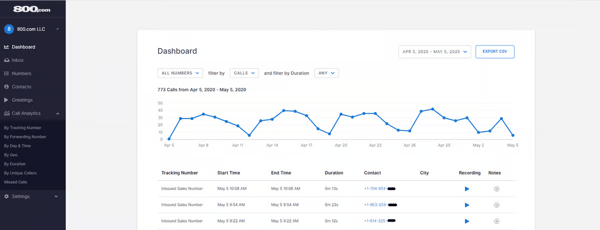
Users often highlight 800.com’s useful call tracking features, which help businesses effectively monitor and manage inbound calls. One downside I’ve noticed in reviews is that it can be more expensive than other pay-as-you-go services. While the features are helpful, the pricing may not be ideal for businesses that require occasional call tracking. Still, many reviewers feel the quality and reliability of the service justify the higher cost.
Another strength is the platform’s toll-free number setup, which allows businesses to create a professional presence. G2 reviewers mention that while the verification rules for setting up a toll-free number are understandable, the process can feel restrictive. There are specific compliance requirements to meet, and making changes isn’t always straightforward. Yet, users generally find that once verification is complete, the system works smoothly and provides dependable performance.
What I like about 800.com:
- I’ve seen G2 users appreciate how 800.com helps businesses appear more professional and established by offering toll-free numbers. Having a recognizable and trustworthy number can make a significant difference when trying to establish credibility with potential customers.
- I've noted that reliable call forwarding is another feature that gets strong praise. Reviewers mention that 800.com consistently routes calls without unnecessary disruptions, which helps ensure that important business calls aren’t missed.
What G2 users like about 800.com:
“800.com has outstanding customer service and offers the best products to its customers. They allow smaller businesses to instantly gain credibility by offering 800 numbers, including 800 vanity numbers, at a great value. Plus, they'll respond promptly and provide the right solution for any issues. 800.com is an instrumental part of any organization's communications and contact system.”- 800.com Review, Arziki P.
What I dislike about 800.com:
- One drawback I’ve noticed is that 800.com can be more expensive than some other pay-as-you-go options.
- I’ve seen G2 reviewers mention that while the verification rules for setting up a toll-free number make sense, there are compliance requirements that need to be followed closely, and if any changes are needed, it can quickly become a hassle.
What G2 users dislike about 800.com:
“While the service is good, it is slightly more expensive than some competitors, which might be a consideration for small businesses on a tight budget.”
- 800.com Review, Boris V.
Best inbound call tracking software: Frequently asked questions (FAQs)
1. What is the best software for call tracking?
CallRail, Invoca, and Ozonotel CloudAgent are the best call tracking software solutions.
2. What is the best inbound call tracking software for Android?
For inbound call tracking on Android, CallRail is a top choice, offering comprehensive call tracking and analytics features. CallTrackingMetrics is another excellent option, providing robust call management and tracking capabilities. Additionally, WhatConverts offers a user-friendly interface with powerful call tracking functionalities, making it suitable for marketers and agencies.
3. What is the best Call tracking software for lead generation?
For effective lead generation, CallRail offers comprehensive call tracking and analytics to optimize marketing campaigns. Similarly, CallTrackingMetrics offers robust call management features, facilitating efficient lead tracking and conversion.
4. How does inbound call tracking work?
Inbound call tracking assigns unique phone numbers to marketing campaigns, channels, or sources. When a customer calls one of these numbers, the system records details like the caller’s number, call duration, and source. Advanced software can analyze call data, track conversions, and integrate with CRM tools. This helps businesses measure the effectiveness of their marketing efforts and optimize lead generation strategies.
5. What are the best free inbound call tracking apps?
For free inbound call tracking, CallRail offers a comprehensive free trial that includes features such as call recording and analytics. Ringba provides a free plan suitable for businesses seeking basic call tracking capabilities. Additionally, Nimbata offers a free tier with essential call tracking functionalities.
Turn every ring into revenue
Inbound call tracking software is the missing link in a data-driven sales and marketing strategy. The days of guessing where leads come from or scrambling for context mid-conversation should be a thing of the past. With the right software, every call becomes an opportunity, every lead a traceable asset, and every conversation a chance to close confidently.
However, not all inbound call tracking solutions are built the same. When choosing one, consider your business’s needs: do you require in-depth analytics or basic call attribution? Will you benefit from AI-powered insights, call recording, or CRM integrations? And most importantly, is the pricing aligned with the value you’ll get? The best inbound call tracking solution is one that accurately tracks calls and helps you convert them into real business growth.
Learn how the best customer journey analytics solutions help you execute customer behavior-driven strategies.










.png)


